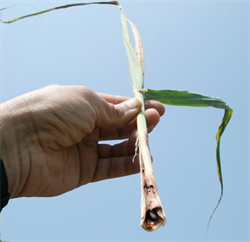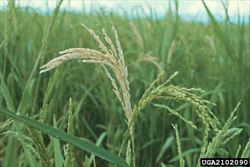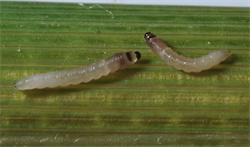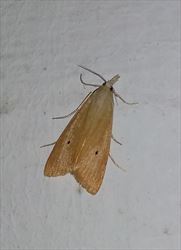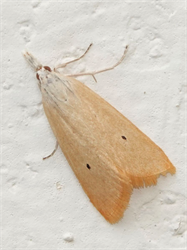Yellow stem borer. It is also known as the paddy stem borer, yellow rice borer.
Pacific Pests, Pathogens, Weeds & Pesticides - Online edition
Pacific Pests, Pathogens, Weeds & Pesticides
Rice yellow stem borer (533)
Scirpophaga incertulas; previously known as Chilo incertulas. There are other Scirpophaga species on rice (see Fact Sheets nos. 408, 411, 412), and there has been confusion in the past in the identification of Scirpophaga incertulas, with males and females thought to be different species. A member of the Crambidae (snout moths).
Asia, Africa (Egypt), Europe (Spain), Oceania. It is recorded from Australia, Papua New Guinea.
Rice, cultivated and wild species.
The rice yellow stem borer is the most common species in tropical wetland areas, and is a major pest of tropical lowland and deep-water rice. It attacks all stages of the crop. Eggs are laid on upper-surface (and upper half) of leaves in groups (average about 80) covered in tan scales from the female. Eggs hatch in 5-10 days, and the white larvae bore into the leaf sheath resulting in yellowish-white patches. Later, they invade the stem, and cause deadhearts or drying up of the central shoots (at the vegetative stage), and whiteheads (at the panicle stage) (Photos 1-3). When fully grown (20-40 days) the larvae are pale-yellow to yellowish-green with a brown head, up to 20 mm long (Photo 4). They pupate in white silk cocoons made in hollow stems at the base of the plant. In deep-water rice, the larvae and pupae may be beneath the water.
The larvae become dormant if dry periods occur or in seasons when rice is not grown. During rice-free times, the larvae remain in the stubble below the soil. Mortality is high (90%) during periods of dormancy, due to destruction of stubble, and possibly due to predation (spiders) and adverse environments (droughts).
The female moth has pale-yellow or light-brown forewings, each with a characteristic single, black spot (Photos 5&6). The smaller grey or light-brown male has two rows of small spots at the tip of each forewing. Females are 13 mm long with 32 mm wingspans.
Spread over short distances occurs as eggs on infested seedlings used for planting; as larvae that crawl from plant to plant and/or disperse on silken threads blown by the wind, as pupae in harvested stems, adults on the wing at night, and on farm machinery.
Among the stem borers infesting rice, the yellow stem borer is one of the most important pests throughout tropical South and Southeast Asia. To some extent, plants can compensate for the damage by producing more tillers or providing extra nutrients to those that survive, but they are still likely to suffer yield loss when more than one tiller is damaged per hill. In terms of the economics, CABI maintains that it is very difficult to translate the damage into economic impact, because many of the estimates of loss are from outbreak situations, and are not annual occurrences. Also, the estimates are not for the yellow stem borer alone.
Nevertheless, CABI estimates that damage by rice stem borers to be between 3 and 3.5%, and one third of that is due to the yellow stem borer alone. Using figures for rice production in tropical and sub-tropical Asia for 1999-2000, CABI estimates that the value of the lost grain is between US$1250 and US$1450 million. A considerable amount.
Look for the damage done by the yellow stem borer: deadhearts that can be easily pulled from the base of the plants during the vegetative stage, and whiteheards during the reproductive stage. Look for larvae (and frass) and pupae in the pulled-out stems to confirm the damage was caused by yellow stem borer. Look for small holes on the tillers. Look for a yellowish-green moth with a characteristic single, black spot on each forewing. Because adults of several rice stem borers are similar, specimens should be checked by taxonomists with expertise in moth pests of rice.
BIOSECURITY
Countries not yet infested by the rice yellow stem borer should consider all likely pathways for entry, and apply quarantine measures accordingly. Many countries throughout Africa, the Americas, the Caribbean, and Oceania are at risk. Pathways of introduction are likely to be via produce contaminated by pieces of rice stem infested with larvae and/or pupae.
BIOLOGICAL CONTROL
Many egg parasioids have been identified with Telenomus spp., Tetrastichus spp., and Trichogramma spp. being the most common. There are also predators of eggs, e.g., long-horned grasshoppers, and adults are vulnerable to spiders. Every effort should be made to preserve this fortunate situation. Only apply pesticides as a last (and not a first) resort.
To see if chemical control is needed, count the number of eggs that are parasitised, as follows:
- Count number of egg masses on 20 hills observed at random diagonally across the field
- The economic threshold is:
- 2 or more egg masses up to panicle initiation stage, OR
- 1 egg mass thereafter
- Collect the egg masses and put them in vials or jars.
- If more parasitoids emerge than larvae: DO NOT SPRAY.
- If more larvae emerge than parasitoids: SPRAY.
- Carry on monitoring.
The Economic Threshold in Bangladesh is 3 egg masses or 10-15% deadhearts.
CULTURAL CONTROL
Before planting:
- Handpick and destroy egg masses in the seedbed (nursery) beforer transplanting the field.
- Before transplanting, cut the leaf-top to reduce carry-over of eggs from the seedbed to the field.
- Choose short-stature, early-maturing varieties.
- Prepare the land thoroughly ensuring vigorous plant growth when planted, and to destroy larvae and pupae from the previous crop.
During growth:
- Try to synchronise planting in any area, avoiding overlapping crops and preventing pest populations moving from harvested to standing crops. Additionally, choose varieties with similar times to maturity.
- If the crop is seasonal, plant early. Two early-maturing crops may be less damaged than a single late-maturing variety.
- Raise level of irrigation water periodically to submerge any eggs deposited on the lower parts of the plant.
- Weed as soon as required to promote good crop growth.
- Cut out the stems with deadhearts and remove from the field. Destroy the larvae or burn the stems. Note, this is labour intensive and not very effective as the pest may already have left the stem.
- Split applications of nitrogen fertiliser. High nitrogen application favours build-up of stem borers.
After harvest:
- Harvest crops at ground level to remove the larvae and pupae in the stubbles.
- Plough remaining rice stubble into the soil to kill larvae and pupae, and avoid leaving unharvested or volunteer plants. Irrigate the field, if that is possible at this time.
RESISTANT VARIETIES
Most of the modern semi-dwarf rice varieties now grown by farmers have a moderate level of resistance to stem borers, but efforts to produce highly resistant varieties through conventional breeding and wide hybridization with wild rice species have not been successful, but research continues. Genetic modification of varieties with crystal toxin genes from Bacillus thuringiensis has been done, but release is still under consideration.
CHEMICAL CONTROL
The use of insecticides risks destroying natural enemies, and some products recommended for this and other stem borers are extremely toxic and risk harm to users and the environment (e.g., carbofuran, monocrotophos and phorate). Three others commonly recommended insecticides - diazinon, chlorpyrifos and fipronil - are all classified by WHO as Class II moderately hazardous pesticides. They are broad-spectrum insecticides. In addition, fipronil is highly toxic to fish, and it has been associated with colony collapse disorder of bees.
If insecticides are required as a 'last resort' action, consider using biorational products, for instance:
- Bt, the toxin from a bacterium, Bacillus thuringiensis.
- Abamectin, a natural fermentation product from an actinomycete, Streptomyces avermitilis.
- Spinosad, chemical products from a bacterium, Saccharopolyspora spinosa.
____________________
When using a pesticide, always wear protective clothing and follow the instructions on the product label, such as dosage, timing of application, and pre-harvest interval. Recommendations will vary with the crop and system of cultivation. Expert advice on the most appropriate pesticide to use should always be sought from local agricultural authorities.
AUTHOR Grahame Jackson
Information from Stem borer Rice Doctor IRRI (https://keyserver.lucidcentral.org/key-server/data/0e090d01-0209-460e-810c-0d060708030c/media/Html/Stem_borer.htm); CABI (2021) Scirpophaga incertulas (yellow stem borer). Crop Protection Compendium. (https://www.cabi.org/cpc/datasheet/49009); and Scirpophaga incertulas (2021) Wikipedia. (https://en.wikipedia.org/wiki/Scirpophaga_incertulas); and Rice stem borers in the Philippines (1999)Department of Agriculture. Philippines Rice Research Institute. Rice Technical Bulletin No. 20. Maligaya. Philippines. (https://www.pinoyrice.com/wp-content/uploads/rice-stem-borers-in-the-philippines.pdf); and from Cohen MB, et al. (2000) Dispersal by larvae of the stem borers Scirpophaga incertulas (Lepidoptera: Pyralidae) and Chilo suppressalis (Lepidoptera: Crambidae) in plots of transplanted rice. Environmental Entomology 29(5): 958–971. Photo 4 Yellow stemborer: Scirpophaga incertulas. Part of the image collection of the International Rice Research Institute (IRRI).(https://www.flickr.com/photos/ricephotos/368501400/in/gallery-43285328@N08-72157622553615840/). Photo 5 Shino Jacob Koottanad Scirpophaga incertalas, rice yellow stem borer. (https://commons.wikimedia.org/wiki/File:Scirpophaga_incertulas_-_moth.jpg). Photo 6 Scirpophaga incertulas Walker, 1863. Observed in India by Subhadra Devi. (https://www.gbif.org/occurrence/3112620985).
Produced with support from the Australian Centre for International Agricultural Research under project HORT/2016/185: Responding to emerging pest and disease threats to horticulture in the Pacific islands, implemented by the University of Queensland, in association with the Pacific Community.
